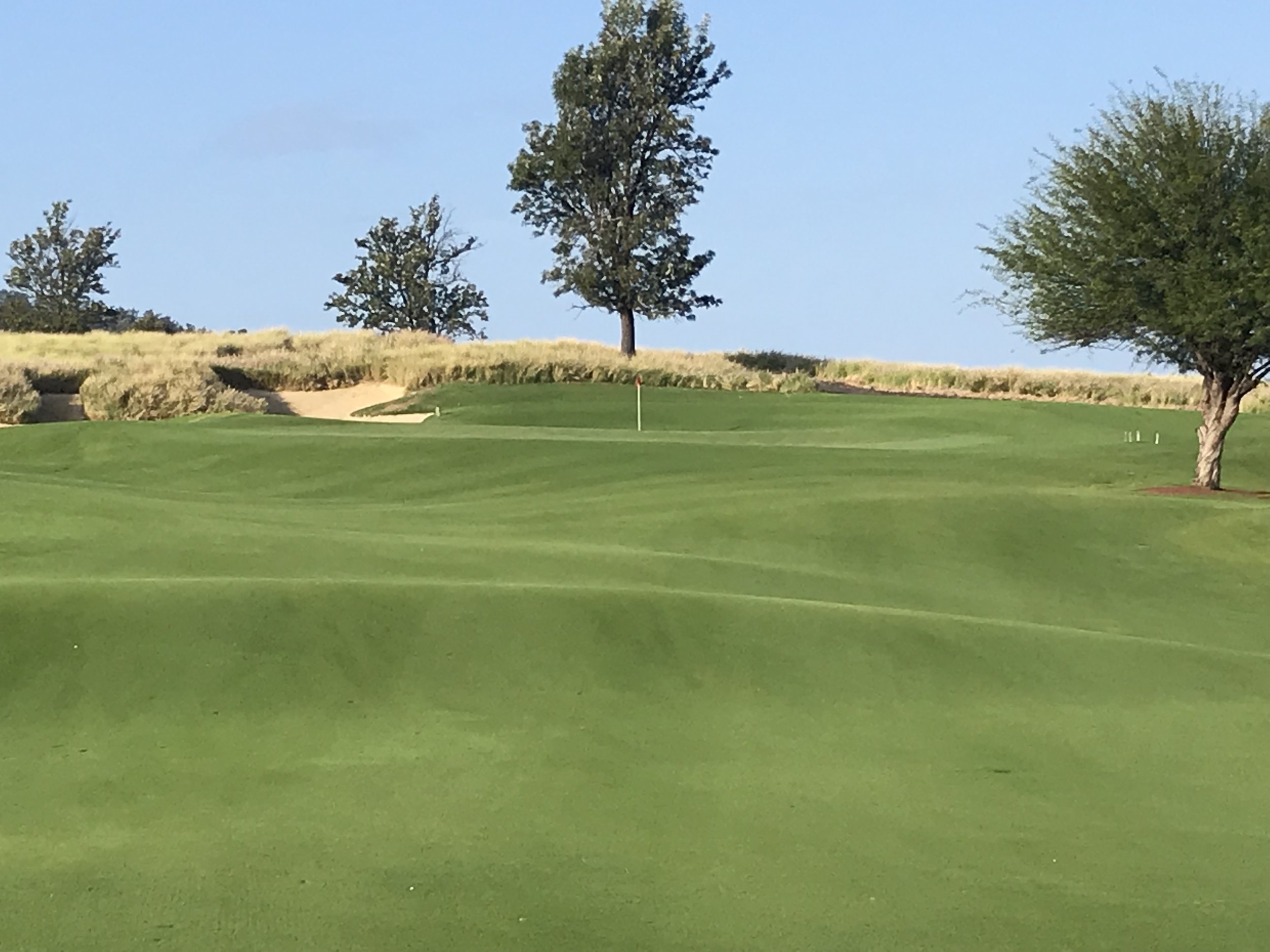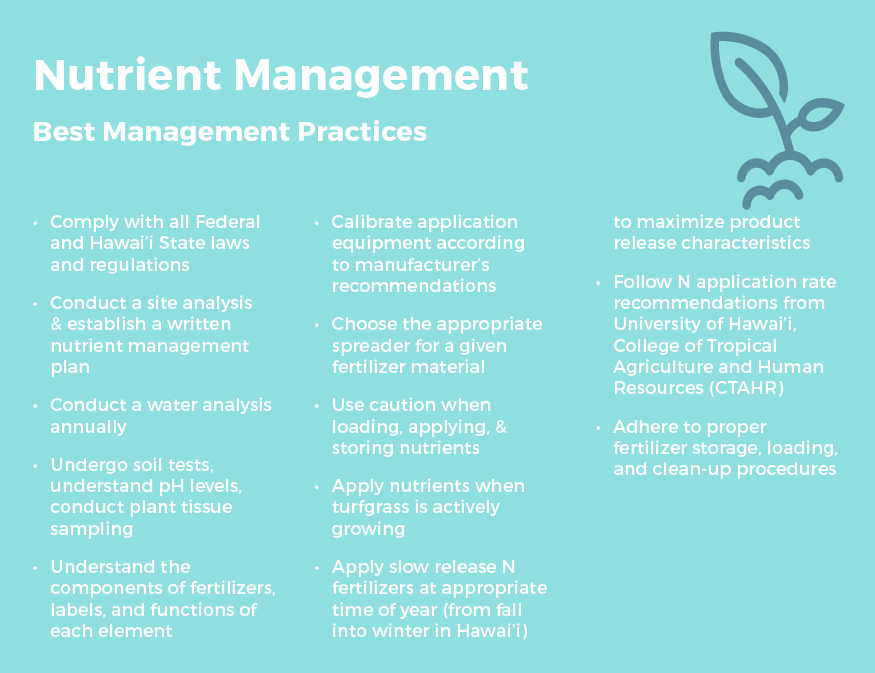7 - Nutrient Management

Proper nutrient management plays a key role in the reduction of environmental risk and improvement of golf course economic sustainability.
Hawai’i environmental conditions vary greatly including differences between soils, topography, rainfall, and temperature. These differences require a nutrient management plan that allows turfgrass managers to address unique needs.
Proper nutrient management plays a key role in the reduction of environmental risk and improvement of golf course economic sustainability. Among other benefits, applied nutrients allow turfgrass to recover from damage and player wear. Nutrients also increase turf resistance to stresses such as drought, disease, and insects. The goal is to apply the minimum necessary to achieve an acceptable playing surface, if not applied properly, nutrients may move beyond turfgrass via leaching or runoff. It is crucial to have an understanding of application rates and timing for effective use of applied nutrients at minimum environmental risk.
SITE ANALYSIS
A nutrient management plan should be established in written format and shared with all parties associated with management of the site. The site can be divided by soil types if there are great fluctuations in nutrient content and/or soil pH. Sites can also be divided into playing surfaces and non-turf landscaped areas, and, by water sources if it varies in quality within the site. Research your soil types, water sources, and drainage plans to aid in selecting the right products. Some products leach quickly through certain soils and if water is high in sodium or bicarbonates it affects the plant’s ability to assimilate nutrients.
Three types of professional analysis provide a foundation for the nutrient management plan, soil, water, and plant tissue sampling. Proper soil sampling, laboratory analysis, interpretation of results, and professional recommendations, can show what nutrient base is present and what is available. Take ten to 15 random soil samples from each site. Each sample should be from the same depth. Soil analysis combined with proper plant tissue sampling can provide the best picture of what is missing and what needs to be done to remediate the soil. Soil testing may be conducted by your local extension agent with your University or Community College.
For plant tissue sampling, two to four tests per year is common on greens and one to two tests per year on tees and fairways. The largest input to turfgrass is often water applied through irrigation. Impacts of water quality can have significant impacts on soil nutrients, soil structure, and nutrient availability. Water tests, along with soil sampling, will provide the greatest level of understanding to the proper ratios of applied nutrients required. Keep accurate records to show impact from your nutrient management plan. Managing a spreadsheet of sampling over time greatly assists in understanding overall long term impact on soil and plant health.
FERTILIZERS USED IN GOLF COURSE MANAGEMENT
Understanding components of fertilizers, the label, and function of each element within the plant are essential to an efficient nutrient management program. Depending on the species, plants need approximately 16 elements, divided into two categories: macronutrients and micronutrients. Macronutrients carbon, hydrogen, and oxygen are derived from carbon dioxide and water. Macronutrients are further subdivided into primary (nitrogen, phosphorous, potassium) and secondary nutrients (calcium, magnesium, sulfur).
Source: https://extension.psu.edu/turfgrass-fertilization-a-basic-guide-for-professional-turfgrass-managers
MACRONUTRIENTS
A fertilizer bag typically displays three numbers equating to the percent by weight of (N) nitrogen, (P) phosphorous, and (K) potassium guaranteed to be in the fertilizer. A complete fertilizer contains N, P2O5, and K2O. N, P, and K are required in the greatest quantities by turfgrass. Nitrogen is required in the greatest quantity after carbon, hydrogen, and oxygen.
Role of Nitrogen (N)
Nitrogen plays key roles in plant functions including an essential component of amino acids, proteins, and nucleic acids. Understanding the below processes can increase ability to make sound management decisions.
Nitrogen Processes
Each N source is unique and should be managed accordingly. Applying a polymer-coated urea in the same manner you would apply a sulfur-coated urea greatly reduces the value of the polymer coated urea. Similarly, applying two pounds of N from ammonia sulphate may cause burning, while applying two pounds of N from certain polymer-coated ureas may not provide the desired turfgrass response. Rate, release curve, application date, location, turfgrass species, and seasonality should be included in the nutrient application decision.
Role of Phosphorous (P)
Phosphorous is essential for plant growth and is involved in the transfer of energy within the plant. It is often the limiting factor in many natural systems. It can be abundant in some soils and is a major contributor to eutrophication of water bodies. It should never be added to turf without a specific reason. Soil and tissue testing will be the best tools to arrive at sufficient application rates. P deficiency symptoms include slow growth and weak stunted plants. P tends to bind to soil creating less potential for leaching versus N.
P fertilizer sources:
Diammonium phosphate
Concentrated super phosphate
Monoammonium phosphate
Natural organics
Role of Potassium (K)
Potassium is an essential element directly involved in maintaining the water status of the plant, turgor pressure of cells, and opening and closing of the stomata. Potassium needs to be maintained at sufficient levels because of its major “health” influence strengthening the turf plant against the stresses of cold, heat, drought, disease, and traffic wear. Potassium is very mobile in the plant, and very soluble and mobile throughout the soil profile. Saline soils and brackish water will create difficulties with plant uptake of K. Deficiency symptoms include interveinal yellowing of older leaves, plus rolling and burning of the leaf tip.
K fertilizer sources:
Potassium sulfate
Potassium chloride
Potassium nitrate
Secondary macronutrients are essential to plant function and are required in lesser amounts than N, P, and K, but more than micronutrients. These include calcium (Ca), magnesium (Mg), and sulfur (S). These elements can be vital when low quality water is applied as a water source.
MICRONUTRIENTS
Micronutrients are as essential for proper turfgrass health as macronutrients, but in very small quantities compared to macronutrients. Micronutrients include (Fe), manganese (Mn), boron (B), copper (Cu), zinc (Zn), molybdenum (Mo), and chlorine (Cl).
SOIL pH
Identifying pH levels may be the most important soil test result for turfgrass managers. In most cases, a pH of 6.3 is ideal because it provides the greatest probability of micronutrient availability. Soil pH adjustments may occur slowly and are temporary.
To increase soil pH, apply a liming material (calcium carbonate, calcium oxide, dolomitic limestone) that contains Ca(2+) neutralize acidity. To lower soil pH, products containing elemental sulfur (calcium sulfate, magnesium sulfate, potassium sulfate) should be applied. It is critical to understand your soil’s nutrient balance before making applications. Applications should be tailored to correct imbalances. In some cases, utilizing injection pumps into irrigation water to address pH can be beneficial.
APPLICATION & MANAGEMENT
Calibration & Equipment
The only way to accurately know how much fertilizer is being applied is to calibrate application equipment. Calibration reduces environmental risk and improves cost savings. Calibration should be done in accordance with manufacturer’s recommendations or when wear or damage is suspected. Sprayer and metering pumps on liquid systems need to be calibrated regularly.
Choose the appropriate spreader for a given fertilizer material. Not all fertilizers can be spread with every spreader. Spreader types include walk-behind rotary, drop spreader, bulk rotary or vicon, and spray. For example, granular fertilizer is usually applied with a rotary spreader. When applying it near waterways, cart paths, or other non-target areas, always use a deflector shield to prevent inappropriate fertilizer distribution. An example of the wrong spreader choice includes applying sulfur-coated urea through a drop spreader, this could damage its coating and lead to an application of soluble urea.
Foliar feeding and liquid fertilization (fertigation) involve the use of a soluble nutrient. Fewer total pounds are applied at any one time, nutrients are used more rapidly, and deficiencies are corrected in less time. Frequent “spoon feeding” is most effective for avoiding accidental fertilizer losses to the environment while also reducing the potential for spikes or low growth rates that impact play, turf recovery, clipping yield, weed establishment, disease outbreaks, and aesthetics.
Storage & Transport
Proper fertilizer storage, loading, and clean-up are important to reduce environmental risk. Load fertilizer into application equipment away from wells or surface water bodies. If a hard surface pad is not available, a tarp can be spread to collect spillage. Clean up spilled material immediately and apply as fertilizer. If fertilizer is deposited on cart paths, parking lots or other impervious surfaces, sweep the material onto the turf to be properly absorbed.
Area & Timing
The reduced height-of-cut and excessive traffic damage on putting greens results in an
increased need for growth leading to an increase in nutrition. Tees and landing areas often have higher fertility requirements than fairways and roughs because they suffer constant divot damage. Fairways and roughs often require less nutrient inputs because of increased height-of-cut, less damage, and clipping return.
Exercise caution when applying nutrient applications during turfgrass establishment as these applications are particularly susceptible to loss via leaching and runoff. Utilize appropriate rates and products to minimize N loss without reducing turfgrass establishment. Consult your local land grant university for efficient N:K in your location.
Avoid applying fertilizer to soils that are at, or near, field capacity or following rain events that leave soils wet. Do not apply fertilizer when the National Weather Service has issued a flood, tropical storm, or hurricane warning, or if heavy rains are likely.
Landcape & Garden Areas
Adding proper soil amendments in garden areas can improve the soil’s physical and chemical properties, increase water holding capacity, and reduce leaching of fertilizers. The use of organic mulches in gardens and aesthetic areas increases moisture-holding capacity of plantings and prevents weed growth when applied in sufficient depth. Organic amendments are decomposed by soil microorganisms and add to soil tilth.













